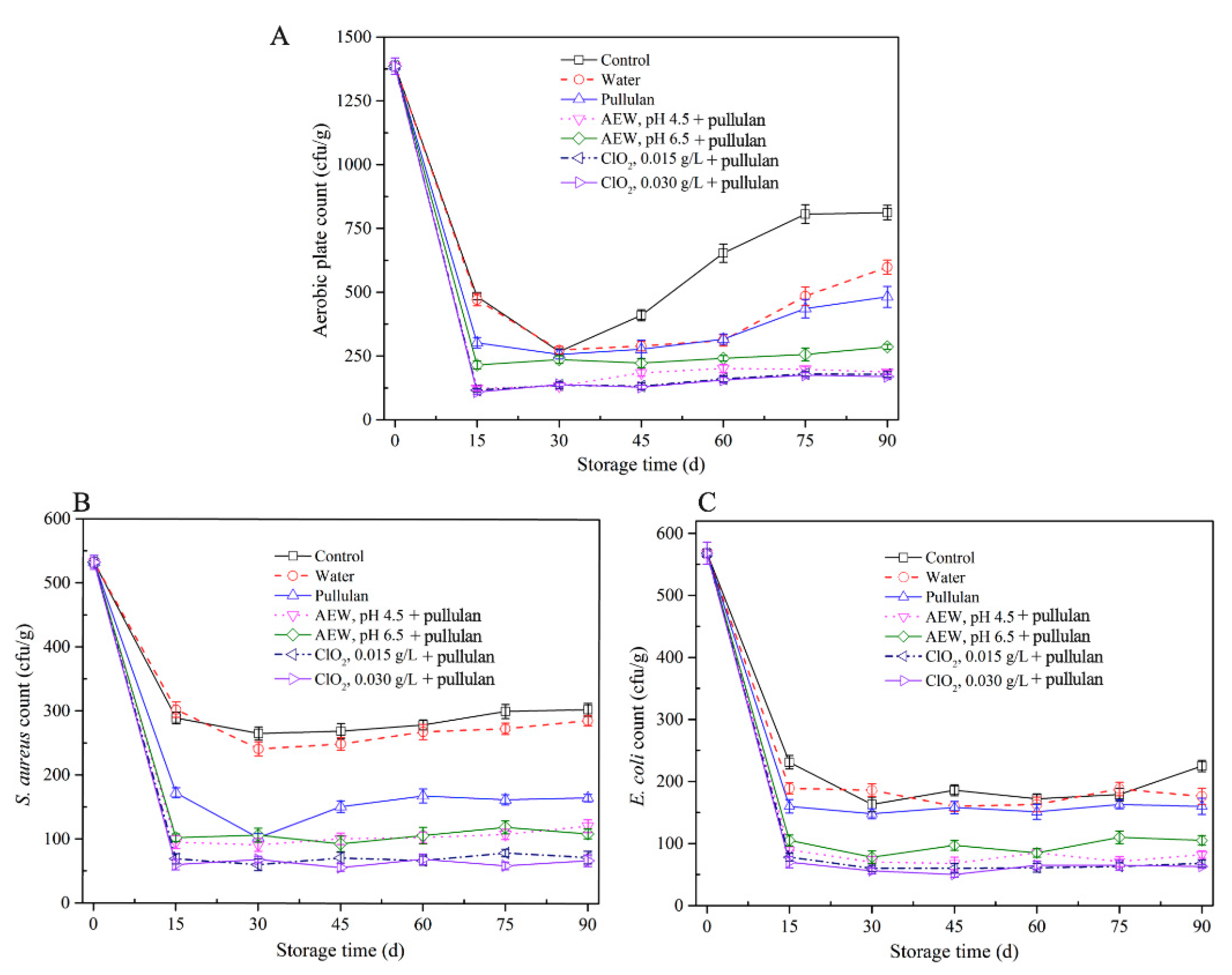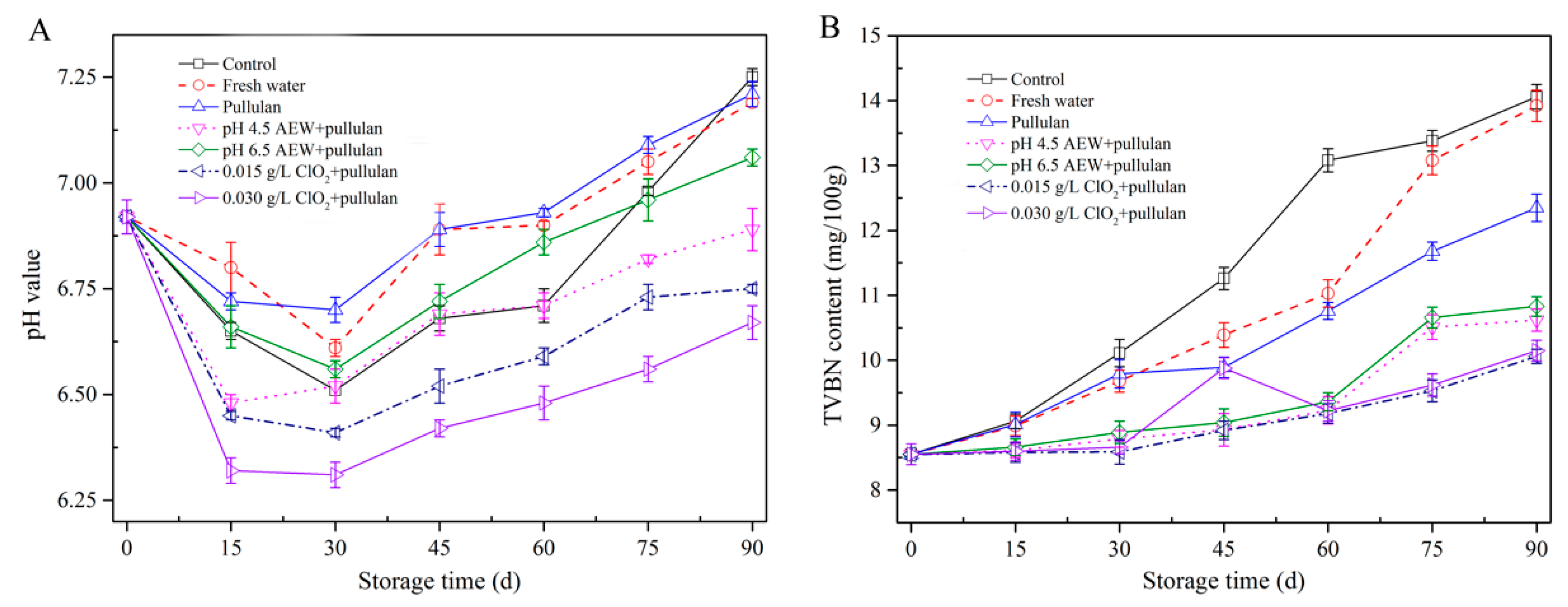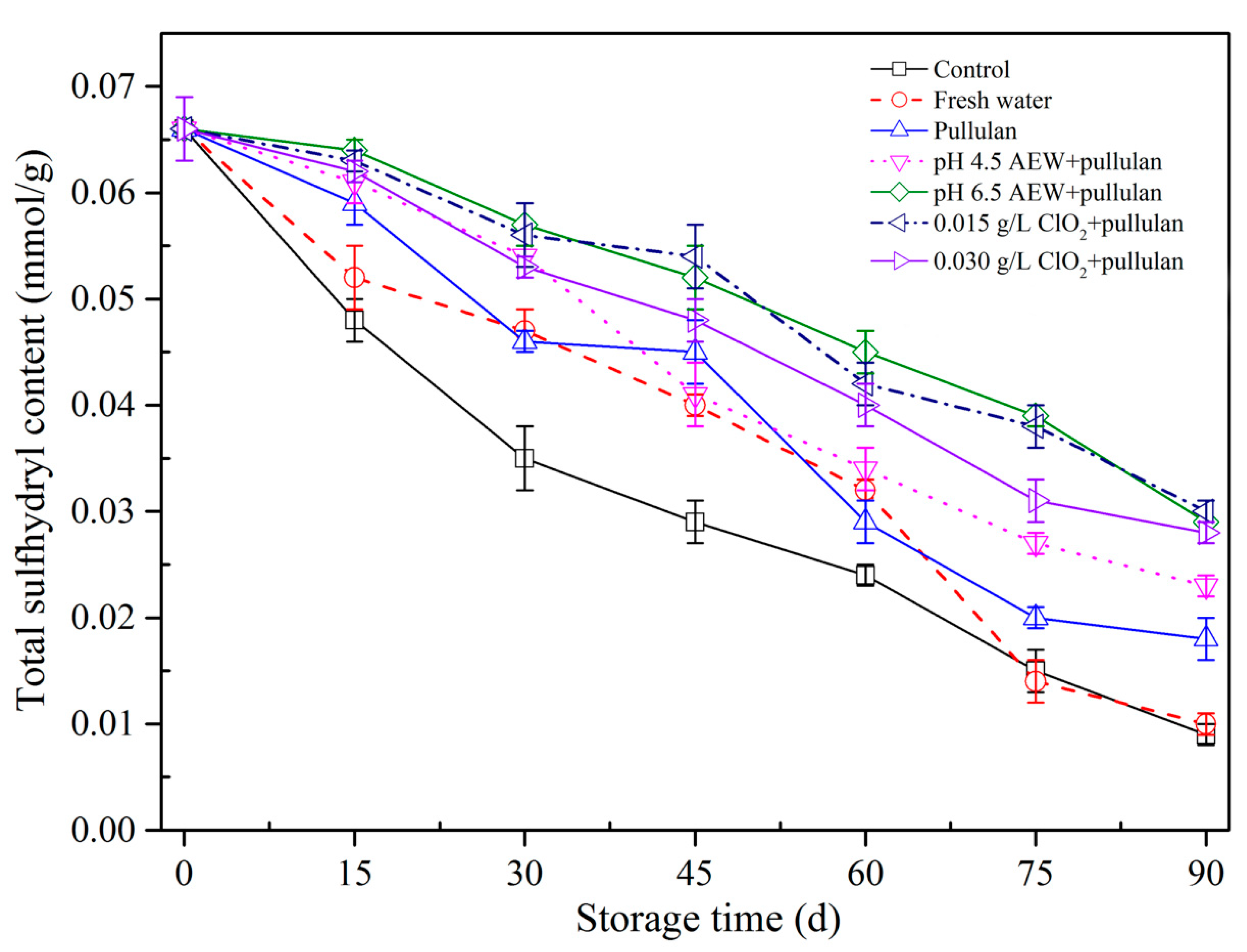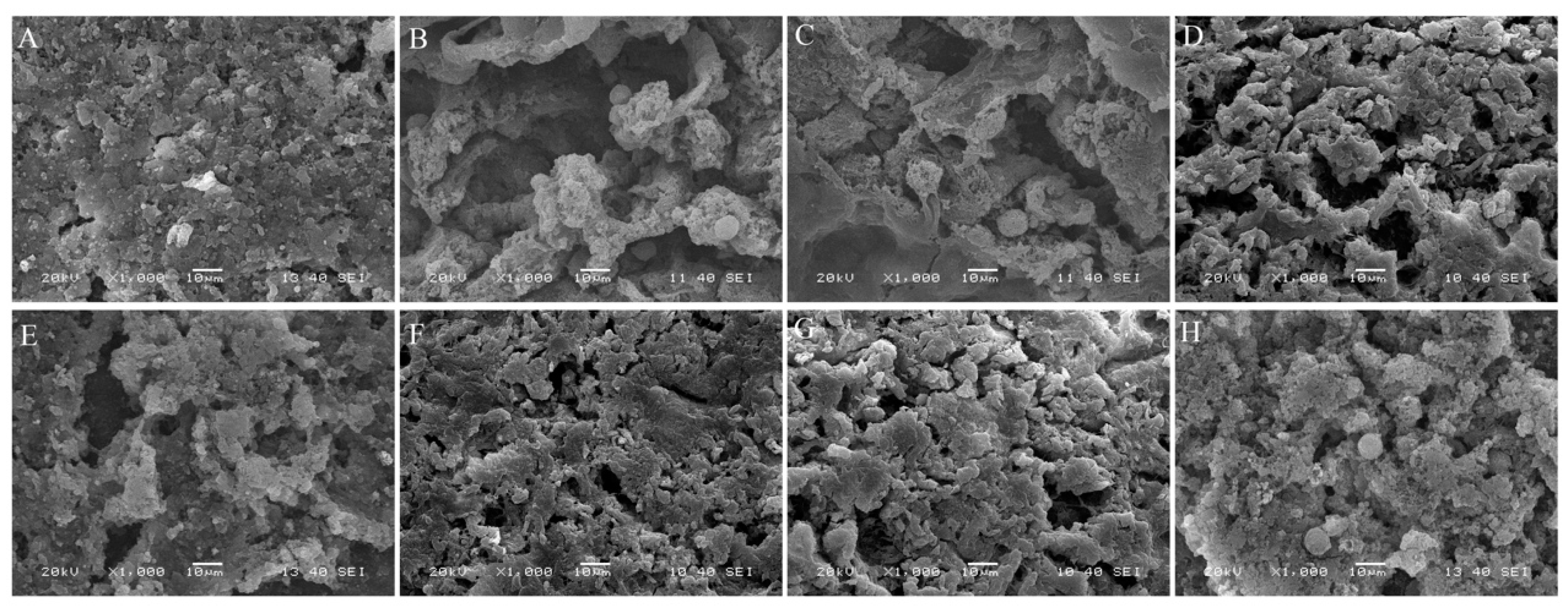Shelf-Life of Half-Shell Mussel (Mytilus edulis) as Affected by Pullulan, Acidic Electrolyzed Water, and Stable Chlorine Dioxide Combined Ice-Glazing during Frozen Storage
Abstract
:1. Introduction
2. Material and Approaches
2.1. Chemicals, Microorganisms and Mussel Samples
2.2. Glazing Process and Frozen Storage
2.3. Microbiological Analysis
2.4. Texture Profile Analysis
2.5. Weight Loss Analysis
2.6. Determination of Total Volatile Base Nitrogen (TVBN) Content
2.7. Determination of Myofibrillar Protein Content and Ca2+-ATPase Activity
2.8. Determination of Total Sulfhydryl Content
2.9. Scanning Electron Microscopy (SEM) Analysis
2.10. Data Analysis
3. Outcomes and Discussions
3.1. Microbiological Analysis
3.2. Texture Analysis
3.3. Weight Loss Analysis
3.4. pH and TVBN Content Analysis
3.5. Myofibrillar Protein Concentration and Ca2+-ATPase Activity Analysis
3.6. Total Sulfhydryl Concentration Analysis
3.7. SEM Analysis
4. Conclusions
Author Contributions
Funding
Institutional Review Board Statement
Informed Consent Statement
Data Availability Statement
Acknowledgments
Conflicts of Interest
References
- Grienke, U.; Silke, J.; Tasdemir, D. Bioactive compounds from marine mussels and their effects on human health. Food Chem. 2014, 142, 48–60. [Google Scholar] [CrossRef]
- Zhou, X.; Zhou, D.; Liu, Z.; Yin, F.; Liu, Z.; Li, D.; Shahidi, F. Hydrolysis and oxidation of lipids in mussel Mytilus edulis during cold storage. Food Chem. 2019, 272, 109–116. [Google Scholar] [CrossRef]
- Vanhaecke, L.; Verbeke, W.; Brabander, H. Glazing of frozen fish: Analytical and economic challenges. Anal. Chim. Acta 2010, 672, 40–44. [Google Scholar] [CrossRef] [PubMed]
- Singh, R.S.; Kaur, N.; Kennedy, J.F. Pullulan production from agro-industrial waste and its applications in food industry: A review. Carbohydr. Polym. 2019, 217, 46–57. [Google Scholar] [CrossRef] [PubMed]
- Farris, S.; Unalan, I.U.; Introzzi, L.; Fuentes Alventosa, J.M.; Cozzolino, C.A. Pullulan-based films and coatings for food packaging: Present applications, emerging opportunities, and future challenges. J. Appl. Polym. Sci. 2014, 131. [Google Scholar] [CrossRef] [Green Version]
- Singh, R.; Kaur, N.; Kennedy, J. Pullulan and pullulan derivatives as promising biomolecules for drug and gene targeting. Carbohydr. Polym. 2015, 123, 190–207. [Google Scholar] [CrossRef] [PubMed]
- Budzinska, K.; Dziedziak, K.; Szejniuk, B.; Traczykowski, A.; Michalska, M.; Berlec, K.; Pasela, R. Effect of chlorine dioxide and hydrogen peroxide on elimination of Salmonella Enteritidis in wastewater from fruit and vegetable-processing industry. Przem. Chem. 2016, 95, 1373–1377. [Google Scholar]
- Phuvasate, S.; Su, Y. Effects of electrolyzed oxidizing water and ice treatments on reducing histamine-producing bacteria on fish skin and food contact surface. Food Control. 2010, 21, 286–291. [Google Scholar] [CrossRef]
- Wang, M.; Wang, J.; Sun, X.; Pan, Y.; Zhao, Y. Preliminary mechanism of acidic electrolyzed water ice on improving the quality and safety of shrimp. Food Chem. 2015, 176, 333–341. [Google Scholar] [CrossRef]
- Lin, T.; Wang, J.J.; Li, J.B.; Liao, C.; Pan, Y.J.; Zhao, Y. Use of acidic electrolyzed water ice for preserving the quality of shrimp. J. Agric. Food Chem. 2013, 61, 8695–8702. [Google Scholar] [CrossRef]
- Chung, C.C.; Huang, T.C.; Yu, C.H.; Shen, F.Y.; Chen, H.H. Bactericidal effects of fresh-cut vegetables and fruits after subsequent washing with chlorine dioxide. Int. Proc. Chem. Biol. Environ. Eng. 2011, 9, 107–112. [Google Scholar]
- Trinetta, V.; Vaidya, N.; Linton, R.; Morgan, M. Evaluation of chlorine dioxide gas residues on selected food produce. J. Food Sci. 2011, 76, T11–T15. [Google Scholar] [CrossRef]
- GB-4789.2. Aerobic Plate Count Examination; National Food Safety Standard of China: Beijing, China, 2016. [Google Scholar]
- GB-4789.10. Food Microbiological Examination: Staphylococcus Aureus; National Food Safety Standard of China: Beijing, China, 2016. [Google Scholar]
- NY/T-555. Detection Methods for Coliform Group, Faecal Coliform Group, Coliform Bacteria in Animal Products; National Agriculture Industry Standard of China: Beijing, China, 2012. [Google Scholar]
- Zhang, B.; Yang, H.; Tang, H.; Hao, G.; Zhang, Y.; Deng, S. Insights into cryoprotective roles of carrageenan oligosaccharides in peeled whiteleg shrimp (Litopenaeus vannamei) during frozen storage. J. Agric. Food Chem. 2017, 65, 1792–1801. [Google Scholar] [CrossRef]
- Zhang, B.; Ma, L.; Deng, S.; Xie, C.; Qiu, X. Shelf-life of pacific white shrimp (Litopenaeus vannamei) as affected by weakly acidic electrolyzed water ice-glazing and modified atmosphere packaging. Food Control 2015, 51, 114–121. [Google Scholar] [CrossRef]
- Zhang, B.; Fang, C.; Hao, G.; Zhang, Y. Effect of kappa-carrageenan oligosaccharides on myofibrillar protein oxidation in peeled shrimp (Litopenaeus vannamei) during long-term frozen storage. Food Chem. 2018, 245, 254–261. [Google Scholar] [CrossRef] [PubMed]
- Zhang, B.; Zhao, J.; Chen, S.; Zhang, X.; Wei, W. Influence of trehalose and alginate oligosaccharides on ice crystal growth and recrystallization in whiteleg shrimp (Litopenaeus vannamei) during frozen storage with temperature fluctuations. Int. J. Refrig. 2019, 99, 176–185. [Google Scholar] [CrossRef]
- Kong, C.; Wang, H.; Li, D.; Zhang, Y.; Pan, J.; Zhu, B.; Luo, Y. Quality changes and predictive models of radial basis function neural networks for brined common carp (Cyprinus carpio) fillets during frozen storage. Food Chem. 2016, 201, 327–333. [Google Scholar] [CrossRef]
- Zhang, B.; Cao, H.; Wei, W.; Ying, X. Influence of temperature fluctuations on growth and recrystallization of ice crystals in frozen peeled shrimp (Litopenaeus vannamei) pre-soaked with carrageenan oligosaccharide and xylooligosaccharide. Food Chem. 2020, 306, 125641. [Google Scholar] [CrossRef] [PubMed]
- He, Q.; Li, Z.; Yang, Z.; Zhang, Y.; Liu, J. A superchilling storage–ice glazing (SS-IG) of Atlantic salmon (Salmo salar) sashimi fillets using coating protective layers of Zanthoxylum essential oils (EOs). Aquaculture 2020, 514, 734506. [Google Scholar] [CrossRef]
- Bierhals, V.S.; Chiumarelli, M.; Hubinger, M.D. Effect of cassava starch coating on quality and shelf life of fresh-cut pineapple (Ananas comosus L. Merril cv “Pérola”). J. Food Sci. 2011, 76, E62–E72. [Google Scholar] [CrossRef] [PubMed]
- Solval, K.M.; Rodezno, L.A.E.; Moncada, M.; Bankston, J.D.; Sathivel, S. Evaluation of chitosan nanoparticles as a glazing material for cryogenically frozen shrimp. LWT Food Sci. Technol. 2014, 57, 172–180. [Google Scholar] [CrossRef]
- Hu, J.; Xu, Y.; Majura, J.; Qiu, Y.; Ding, J.; Hatab, S.; Miao, W.; Gao, Y. Combined Effect of the Essential Oil and Collagen Film on the Quality of Pacific Mackerel (Pneumatophorus japonicus) Fillet During Cold Storage. Foodborne Pathog. Dis. 2021, 18, 1–7. [Google Scholar] [CrossRef]
- Zhang, B.; Hao, G.; Cao, H.; Tang, H.; Zhang, Y.; Deng, S. The cryoprotectant effect of xylooligosaccharides on denaturation of peeled shrimp (Litopenaeus vannamei) protein during frozen storage. Food Hydrocoll. 2017, 77, 228–237. [Google Scholar] [CrossRef]
- Jiang, L.; Wu, S. Pullulan suppresses the denaturation of myofibrillar protein of grass carp (Ctenopharyngodon idella) during frozen storage. Int. J. Biol. Macromol. 2018, 112, 1171–1174. [Google Scholar] [CrossRef]
- Sompongse, W.; Itoh, Y.; Obatake, A. Effect of cryoprotectants and a reducing reagent on the stability of actomyosin during ice storage. Fish. Sci. 1996, 62, 73–79. [Google Scholar] [CrossRef] [Green Version]
- Benjakul, S.; Visessanguan, W.; Thongkaew, C.; Tanaka, M. Comparative study on physicochemical changes of muscle proteins from some tropical fish during frozen storage. Food Res. Int. 2003, 36, 787–795. [Google Scholar] [CrossRef]
- Leygonie, C.; Britz, T.J.; Hoffman, L.C. Impact of freezing and thawing on the quality of meat: Review. Meat Sci. 2012, 91, 93–98. [Google Scholar] [CrossRef] [PubMed]
- Kan, Z.; Yan, X.; Ma, J. Conformation Dynamics and Polarization Effect of α, α-Trehalose in a Vacuum and in Aqueous and Salt Solutions. J. Phys. Chem. A 2015, 119, 1573–1589. [Google Scholar] [CrossRef] [PubMed]







Publisher’s Note: MDPI stays neutral with regard to jurisdictional claims in published maps and institutional affiliations. |
© 2021 by the authors. Licensee MDPI, Basel, Switzerland. This article is an open access article distributed under the terms and conditions of the Creative Commons Attribution (CC BY) license (https://creativecommons.org/licenses/by/4.0/).
Share and Cite
Gao, Y.; Jiang, H.; Lv, D.; Benjakul, S.; Zhang, B. Shelf-Life of Half-Shell Mussel (Mytilus edulis) as Affected by Pullulan, Acidic Electrolyzed Water, and Stable Chlorine Dioxide Combined Ice-Glazing during Frozen Storage. Foods 2021, 10, 1896. https://doi.org/10.3390/foods10081896
Gao Y, Jiang H, Lv D, Benjakul S, Zhang B. Shelf-Life of Half-Shell Mussel (Mytilus edulis) as Affected by Pullulan, Acidic Electrolyzed Water, and Stable Chlorine Dioxide Combined Ice-Glazing during Frozen Storage. Foods. 2021; 10(8):1896. https://doi.org/10.3390/foods10081896
Chicago/Turabian StyleGao, Yuanpei, Huili Jiang, Dandan Lv, Soottawat Benjakul, and Bin Zhang. 2021. "Shelf-Life of Half-Shell Mussel (Mytilus edulis) as Affected by Pullulan, Acidic Electrolyzed Water, and Stable Chlorine Dioxide Combined Ice-Glazing during Frozen Storage" Foods 10, no. 8: 1896. https://doi.org/10.3390/foods10081896
APA StyleGao, Y., Jiang, H., Lv, D., Benjakul, S., & Zhang, B. (2021). Shelf-Life of Half-Shell Mussel (Mytilus edulis) as Affected by Pullulan, Acidic Electrolyzed Water, and Stable Chlorine Dioxide Combined Ice-Glazing during Frozen Storage. Foods, 10(8), 1896. https://doi.org/10.3390/foods10081896






